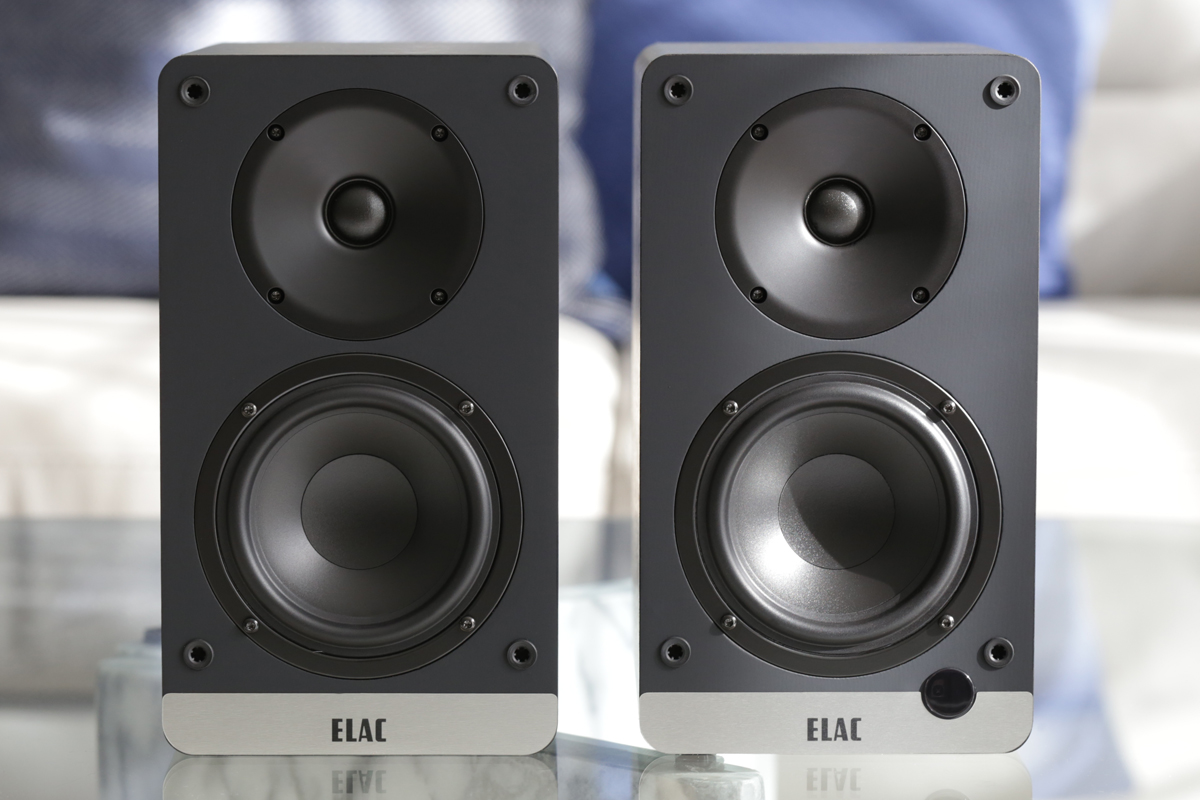Since COVID-19 arrived in North America three years ago, I’ve been to exactly two audio shows, both in my home city: the 2021 and 2022 editions of the Toronto Audiofest. Fellow SoundStagers Doug Schneider and Jason Thorpe also attended TAF 2022, and as Doug outlined in his show report on SoundStage!Global, they came upon some pretty exotic gear at the show.
But as I reported in my show coverage on Simplifi, there were many new products closer to the audio mainstream as well at TAF—including several that deliver “convenient, lifestyle-oriented hi-fi,” the focus of this corner of the SoundStage! Network.
One such product was Elac’s Debut ConneX DCB41 powered speaker system ($599.98, all prices in USD unless stated otherwise): an attractive design with an unusually wide range of inputs, including an HDMI ARC interface and a pair of RCA analog inputs that are switchable between MM phono and line-level operation. The ConneX DCB41 also has Bluetooth connectivity with aptX support.

I was impressed by how good this little system sounded in the demo room of Trends Electronics, Elac’s Canadian distributor; so, the week after the show, I fired off an email to Elac requesting a review sample.
The DCB41 also had some hometown appeal for me. It was designed at Elac Research, based a mere ten miles from the Westin Toronto Airport Hotel where TAF was held, by a team that included Oleg Bogdanov. Formerly director of product development for Paradigm Electronics, Bogdanov briefly worked for Elac following the departure of Andrew Jones in 2022.
Inside and out
Elac’s Debut ConneX DCB41 is sold as a set consisting of a conventional passive speaker and a powered speaker containing all the connectors and the 50Wpc class-D amplifier that powers both speakers. The system is powered as opposed to active, with passive crossovers that come after the amplifier in the signal path. Each speaker measures 5.5″W × 9.6″H × 8″D; the powered speaker weighs 7.6 pounds and the passive speaker weighs 6.3 pounds.
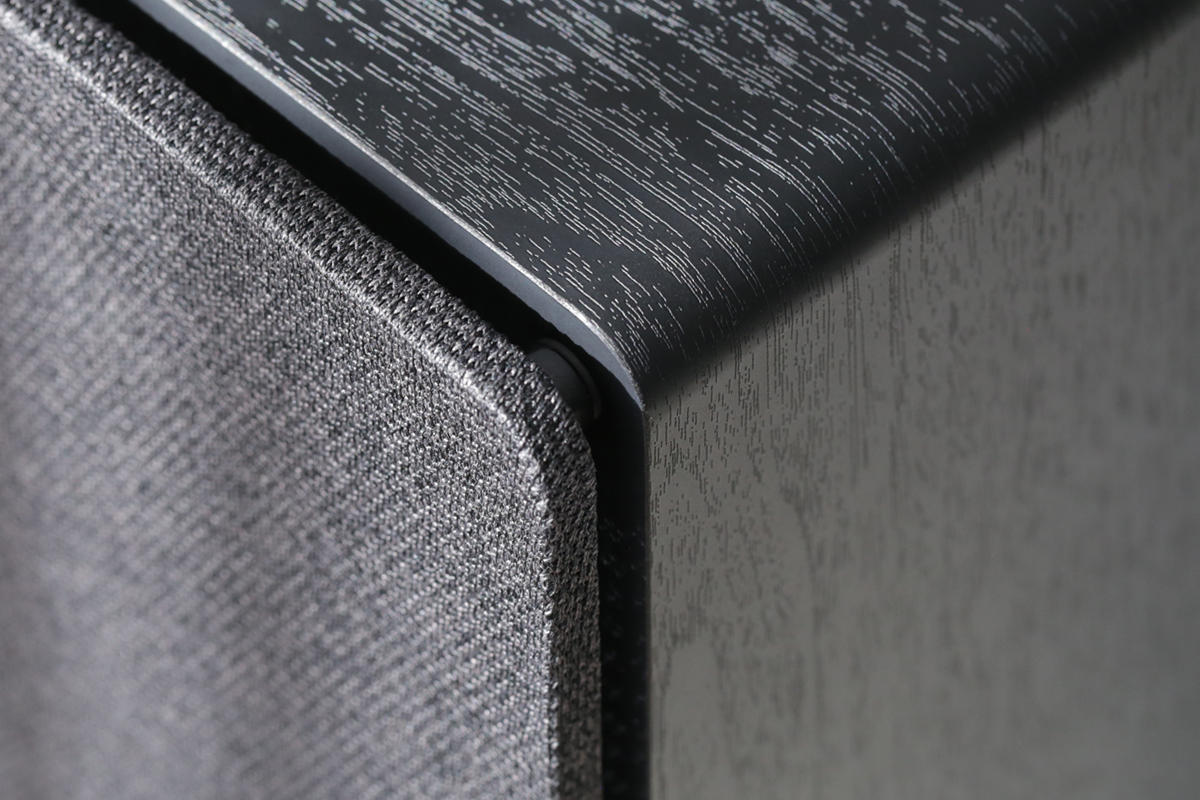
Three finishes are available: Black Ash, Walnut, and Royal Blue. All three versions come with perforated plastic grilles covered in dark-gray cloth. The grille attaches to the front baffle with peg inserts, and the radiused top and bottom edges add a stylish look to the speakers. Considering the price, fit and finish are very good.
The DCB41 is a two-way, rear-ported design employing a 4.5″ polypropylene midrange-woofer that is crossed over at 2kHz to a 0.75″ soft-dome tweeter. Elac says the midrange-woofer’s wide-rolled surround enables longer cone excursion for higher maximum output and deeper bass extension. The waveguide surrounding the tweeter controls directivity and dispersion, Elac says, for improved imaging and tonal balance.
Below the front baffle is a narrow, dark-gray strip displaying a painted Elac logo. The powered speaker has an LED in the lower-right corner of the front baffle. The LED glows and flashes different colors to indicate system status and selected input, and is visible with the speaker grille in place.
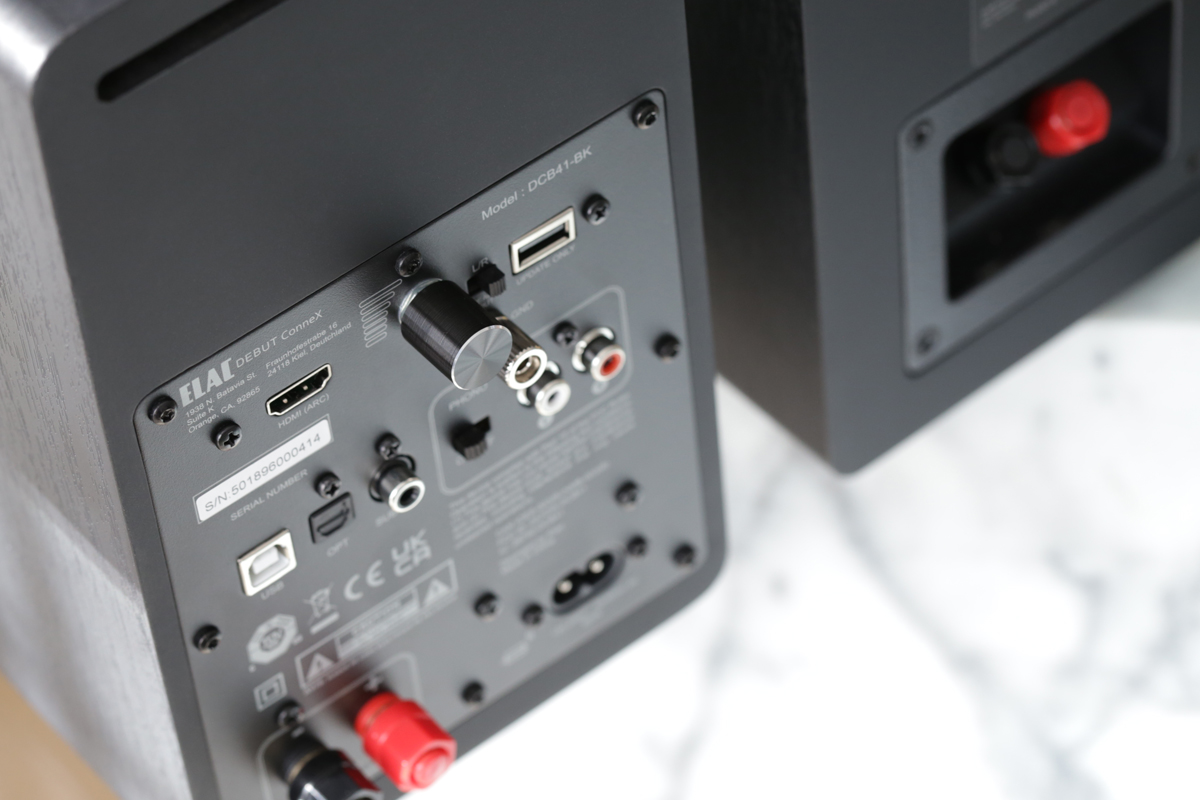
At the top of the back panel on both speakers is a slot-shaped bass port that extends almost the full width of the enclosure. Near the bottom on the passive speaker is a pair of binding posts that receive speaker-level audio from the powered speaker. Elac includes a 6′ stripped and tinned speaker cable with the system.
On the bottom right of the powered speaker is a two-prong power inlet, and on the left a pair of binding posts, labeled Speaker Out, for sending audio to the passive speaker. You can choose whether to send left- or right-channel audio using the two-position Speaker Out switch on the top of the back panel. This useful (and, unfortunately, not universal) control makes it easier to place the powered speaker close to your source components. The powered speaker has an HDMI ARC port (a 5′ HDMI cable is included with the system), a rotary volume control, a USB Type-B port for connection to a computer, an optical S/PDIF (TosLink) input, a subwoofer output jack (RCA), and a pair of RCA analog inputs that can accept line-level or MM phono signals. The USB and TosLink ports can accept PCM audio to 24-bit/96kHz. There’s no low-pass filter for the subwoofer output; crossover frequency has to be set by controls on your subwoofer.
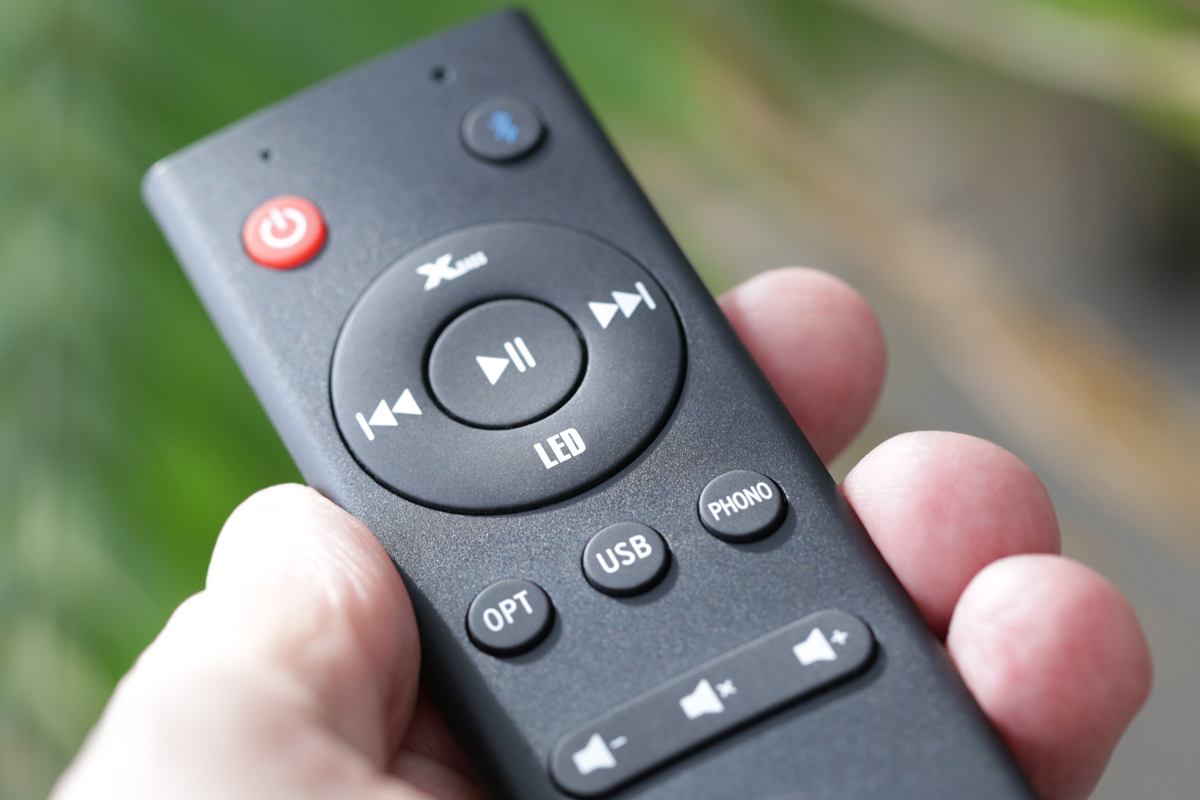
The DCB41 comes with a remote with all the standard-issue playback buttons, plus one for controlling the system’s XBass feature. As the name suggests, XBass processing provides an extra dollop of low-frequency output. There are two settings: Level 1 provides a 3.5dB boost at 55Hz, and Level 2 provides a 7dB boost. If you’re connecting a sub, you should turn XBass processing off.
Listening 1
I started with some nearfield listening, placing the ConneX speakers on IsoAcoustics ISO-130 desktop stands on the top shelf of the secretary desk in my second-floor home office. The tweeters were a little above ear level because of the height of my desk, so I arranged the spacers in the IsoAcoustics stands to tilt the speakers downward until the tweeters were aimed at my ears when I leaned back in my office chair. The speakers were 3′ apart and 3.5′ from my listening position; their back panels were 5″ from the wall behind them.
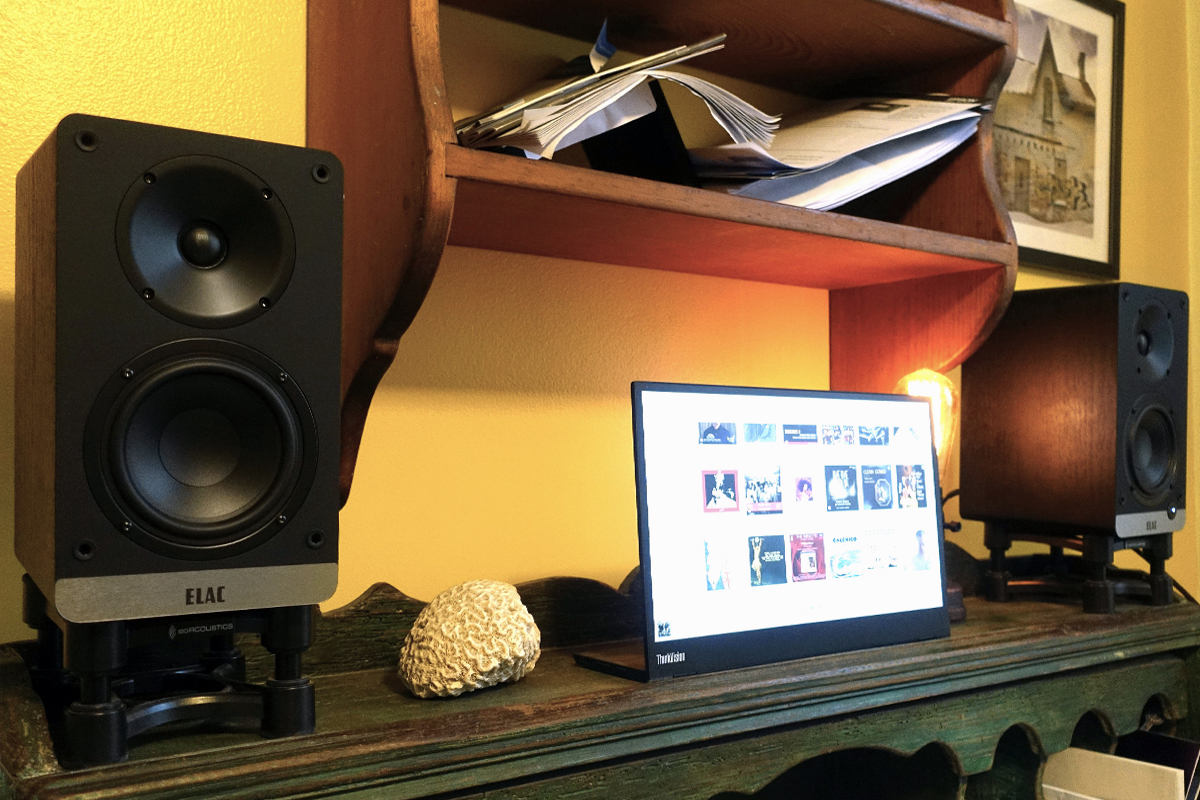
For vinyl playback, I connected my Pro-Ject Debut Carbon Evo turntable ($869 CAD with Ortofon 2M Red cartridge) to the powered speaker’s RCA inputs. The first thing I noticed was the quietness of the DCB41’s phono stage. With my ear only a few inches from the speaker, I could hear no hiss or hum. None.
Playing Kandace Springs’s extraordinary rendition of Screamin’ Jay Hawkins’s “I Put a Spell on You,” from her album The Women Who Raised Me (LP, Blue Note B003159701JK02), I was blown away by how big these little speakers sounded. The first half of the song is underpinned by Springs playing the main theme of the first movement of Beethoven’s “Moonlight Sonata.” For speakers so small, phrases in the low and middle octaves had surprising heft and authority, which effectively communicated the massive power of Springs’s concert grand. Piano tone was consistently accurate throughout the instrument’s entire range.
XBass processing had little effect on the sound of Springs’s piano, but unsurprisingly, it had a major effect on the sound of Scott Colley’s double bass. However, the instrument sounded boomy and indistinct with XBass set at Level 2, and even at Level 1, lower notes were still a bit boomy. Given how close the speakers were to the wall behind them, this didn’t surprise me. With XBass turned off, Colley’s plucks were crisply defined, and the resonance of the soundbox was rich and woody. During the bowed notes Colley plays at the end of the track, I could clearly hear the action of the bow against the strings. Even with XBass off, the double bass sounded fuller and more robust than I’d have expected from speakers this size.
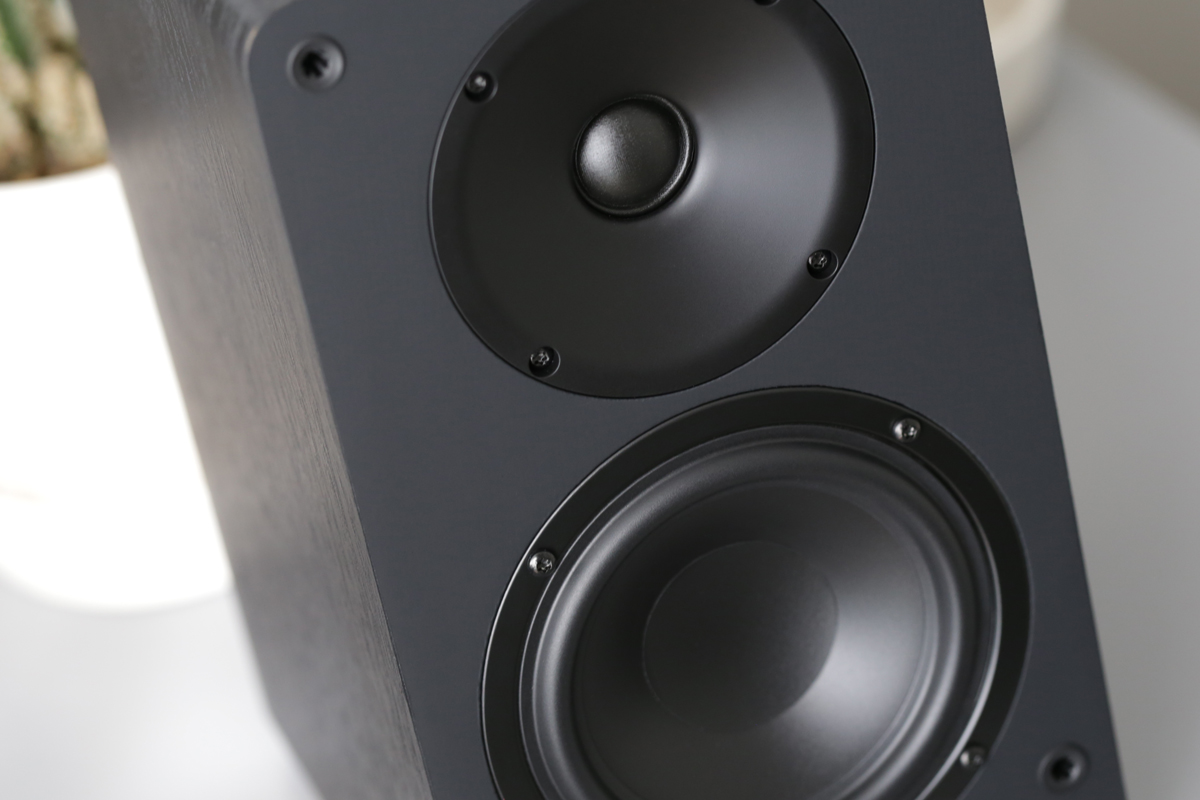
Dynamics were impressive. David Sanborn’s impassioned wailing on alto sax jumped out of the speakers and into my home office. So did Clarence Penn’s bold snare and kick-drum beats. In the most intense passages, with the five musicians going all-out, the sound became a bit thick and congested, but never harsh.
In the center of the soundstage, forward of the rest of the mix, Springs’s alto voice appeared just above her piano. Just as it did with Sanborn’s saxophone, the powered Elac system tracked Springs’s sudden dynamic shifts effortlessly. There are a couple of occasions where Springs adds a breathy or throaty inflection to the lyrics, and these sounded a bit edgy; otherwise, vocal timbre was very convincing. I loved the way the ConneX speakers rendered Springs’s voice when it soared to hit high notes.
The DCB41 threw a soundstage that extended a little above and behind the speaker plane. Imaging was very good, with impressive front-to-back layering: Steve Cardenas’s spooky electric guitar riffs came from the front left, Sanborn’s sax from further back in the center left, Colley’s bass from the center right, and Penn’s drum kit was arrayed across the rear.
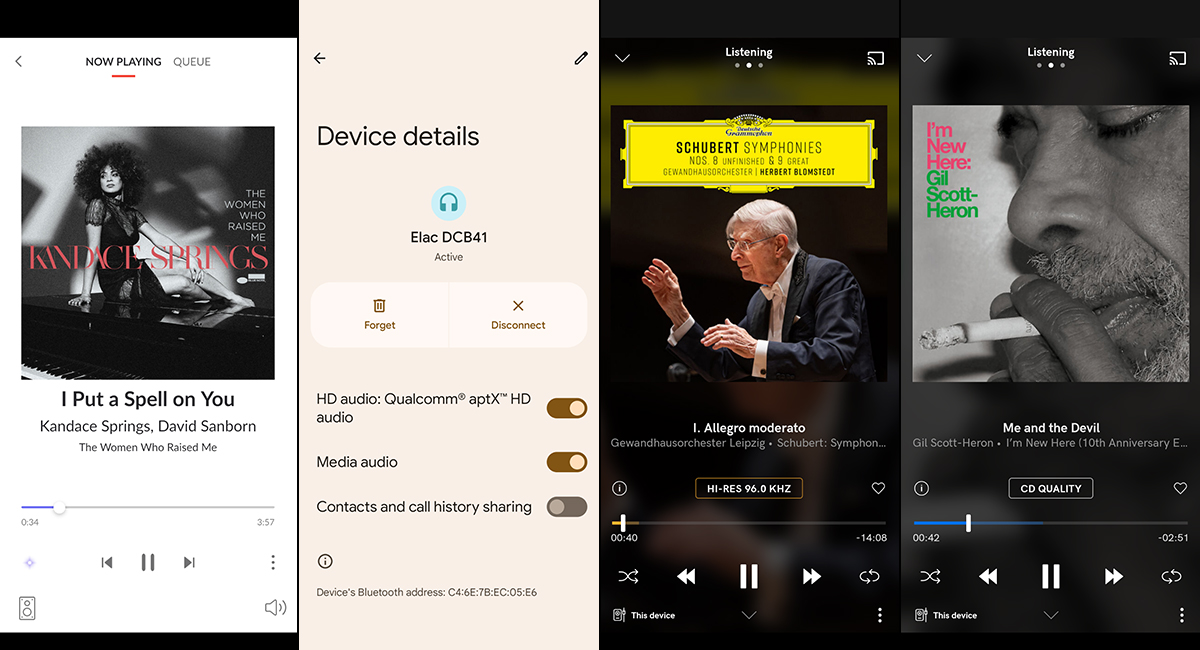
For digital, I connected my Apple Mac Mini, which I use to run Roon Core, to the powered speaker’s USB port. I also listened via Bluetooth from my Google Pixel 4a smartphone.
I began by streaming Springs’s rendition of “I Put a Spell on You” (24-bit/96kHz FLAC, Blue Note / Qobuz), because I wanted to determine whether the mild congestion and occasional edginess I heard on the LP version were due to limitations in my analog setup or the LP itself. With the digital stream, the slightly edgy artifacts on some of Springs’s phrases that I had noticed on the LP were more clearly an expressive vocal technique. And the congestion I heard in the big, intense passages on the LP was gone. Piano tone was just as convincing as it had been with the LP, but transients were crisper, and notes in chords were better differentiated. Sanborn’s alto-sax phrases were more articulate with the digital stream. Imaging was more precise, but while the digital stream was more incisive and revealing, the LP sounded warmer and more inviting—more of a unified whole. What this exercise showed me was that the powered Elac system could handle analog and digital playback very well for its price and size.
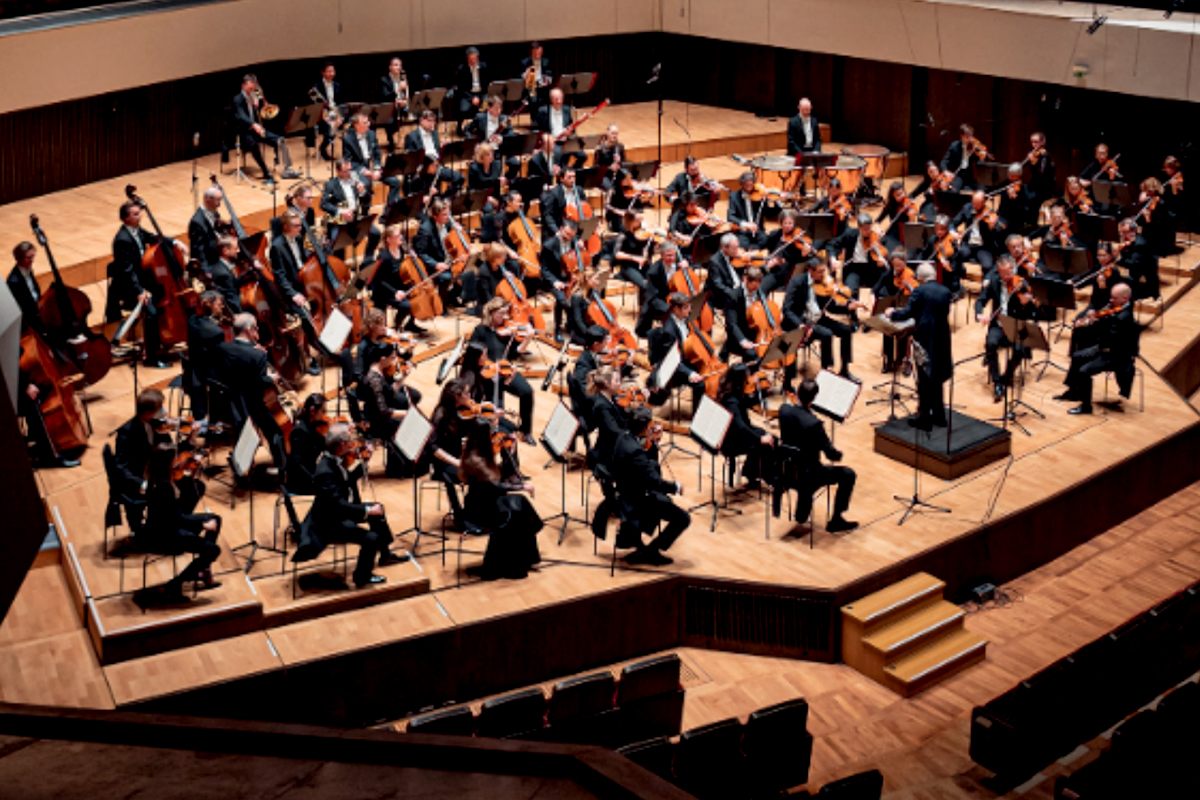
I also wanted to hear how a Bluetooth connection would compare with playback via USB. Figuring orchestral music would highlight whatever differences existed, I cued up a wonderful new recording of Franz Schubert’s Symphony No. 8 (“Unfinished”) by the Leipzig Gewandhaus Orchestra conducted by Herbert Blomstedt (24/96 FLAC Deutsche Grammophon / Qobuz) in the Qobuz app on my Android smartphone. In the phone’s Connected Devices menu, I made sure to enable the aptX codec when sending audio to the Elac speakers.
With XBass set at Level 2, timpani and double basses sounded a little thuddy; again, not surprising given the positioning of the speakers. Setting XBass at Level 1 reduced the thuddiness but did not eliminate it entirely. Still, I enjoyed the extra warmth this setting provided, and the impact it added to the sound of the timpani. With XBass at Level 1, or disabled, I could clearly hear the mallets striking the drumheads, and the reverberation of the drumbeats through Leipzig’s Gewandhaus concert hall. I used the Level 1 setting for my listening on this recording.
Atop my secretary, these small speakers produced a soundstage that extended a foot or so behind the speaker plane, with good front-to-back layering. Instrumental timbres were very convincing. Emerging from the left rear of the soundstage, the double basses and cellos had a lovely growly tone, with just the right amount of texture. I also loved the silky tone of the violins: first violins on the left, second violins on the right. The ConneX speakers made it easy to hear the violinists’ bowing, but the sound was not the least bit scrapy or rosiny. The brass instruments, positioned clearly behind the strings, had a lovely burnished tone. Orchestral textures were transparent, except during loud passages when the sound thickened and hardened slightly, and string tone became a little steely.
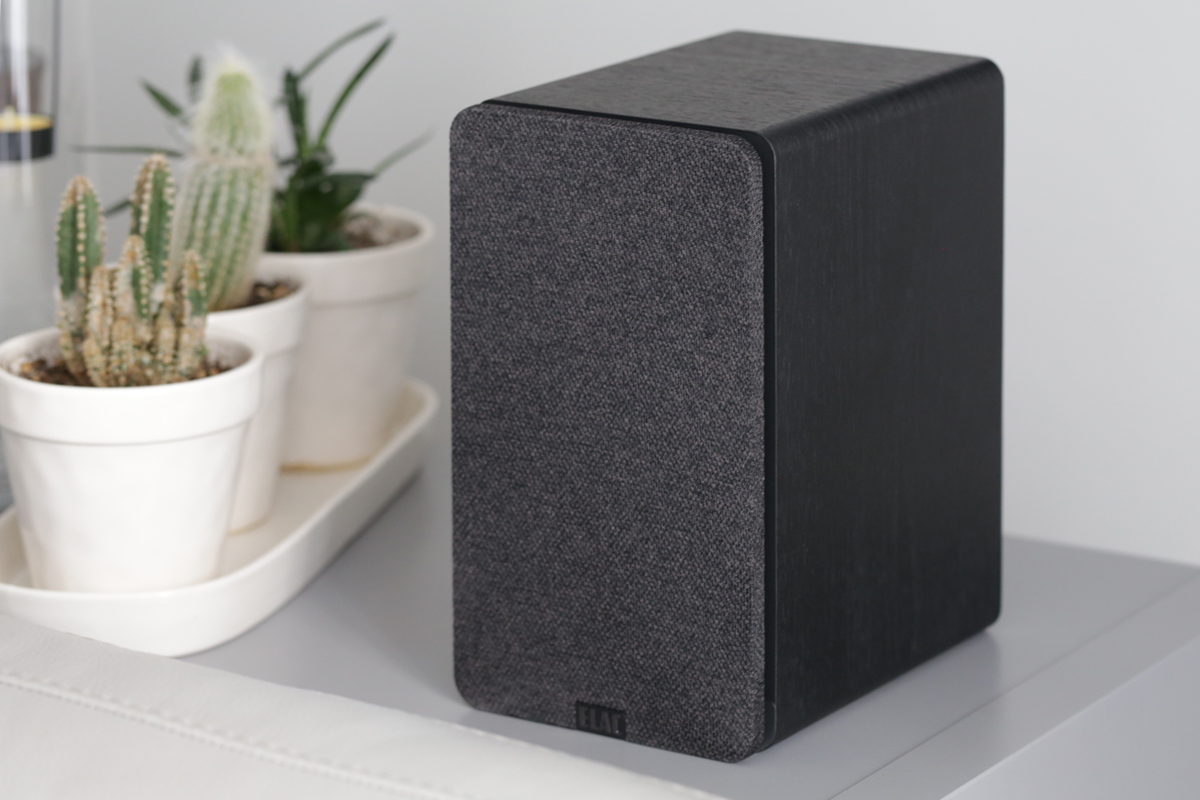
Enjoyable as it was listening to this great recording via Bluetooth, the uncompressed 24/96 stream over USB sounded even better. Orchestral textures were more transparent—the Bluetooth stream sounded a tad homogenized by comparison. Imaging was a little more precise, and front-to-back layering was more delineated, so that it was easier to follow different orchestral lines and groups of instruments. Dynamics were a little bolder—the timpani strokes sounded a bit more dramatic. The greatest difference was in the dense middle section of the first movement—the USB stream was noticeably less congested.
Listening 2
For my second round of listening, I placed the ConneX speakers on the IsoAcoustics stands atop the electric fireplace in our basement family room, underneath a Samsung 50″ Frame TV. I connected the TV’s One Connect breakout box to the powered speaker’s HDMI ARC input. The speakers were 4′ apart and 6′ from my listening position on a small sofa against the opposite wall.
To hear how these little speakers would handle something pretty intense in a larger space than my home office, I cued up Gil Scott-Heron’s rendition of “Me and the Devil,” from his extraordinary album I’m New Here (16/44.1 FLAC, XL Recordings / Qobuz), in the Qobuz app on my smartphone, and streamed it to the DCB41 system via Bluetooth.
Emerging from the back of the soundstage, the nightmarish clapping sounds and industrial effects exploded into the room, creating an appropriately dystopian atmosphere. With XBass set at Level 2, the pounding trip-hop drums and droning synth notes sounded huge and powerful, but also a bit boomy and indistinct. With XBass disabled, these sounds weren’t impactful enough. For this track and this setup, the Level 1 setting for XBass seemed just right. Of course, the drums and synth bass didn’t have the subterranean character you’d get with larger speakers, but they sounded deep and powerful without overwhelming the rest of the mix. This little system nailed Scott-Heron’s raw, bluesy baritone, capturing every rasp and snarl. While there was some dynamic compression, there was no sense of strain or distress. This demanding track showed the limitations of this little system, but also its surprising capabilities.

Next, I cued up the season finale of Severance from the Apple TV+ app on the Samsung Frame TV, which downmixed the Dolby Atmos soundtrack to two-channel PCM. Dialog was crystal clear and tied to the screen, but female voices had a slightly papery edge. With XBass at the Level 2 setting, the heartbeat effects and deep synth notes in the musical score had an ominous, sepulchral quality, but the proximity of the speakers to the front wall meant they were too boomy. Switching to Level 1 reduced the boom markedly, but they were still suitably threatening. Disabling XBass eliminated the boom at the cost of impact, so I settled on Level 1 for the episode. Regardless of the setting, the speakers delivered an immersive experience; background sounds, such as crowds milling around during Lumon Industries’ board reception in the climactic scene, emerged from a couple of feet beyond the speakers’ outer boundaries. This series has an amazing soundtrack, and these little speakers did it justice. Of course, the sound was nowhere near as immersive as a full surround system, but it was in a different league from the Frame TV’s built-in speakers.
Comparisons
Back in my second-floor home office, I compared the ConneX DCB41 with SVS’s Prime Wireless Pro active speakers ($899.99/system). The SVS system does not have a phono stage, but it does have a built-in streamer based on the (flawed) Play-Fi platform, which now supports AirPlay and Chromecast. Each Prime Wireless Pro speaker employs a 5.25″ polypropylene woofer and a 1″ aluminum-dome tweeter, each with its own 50W class-D amp, in an enclosure that’s about 70% larger than each DCB41 speaker.
Given the 50% price premium, and the difference in size and amplifier power, you’d expect the SVS system to sound better, and it did. Listening to the Leipzig Gewandhaus Orchestra’s performance of Schubert’s “Unfinished” symphony, with the ConneX system’s XBass feature set at Level 1, the SVS system could play louder and scaled up more effortlessly to deliver dynamic contrasts. Dynamics were a little compressed on the Elac system by comparison. Double basses and cellos had more growl through the SVS speakers, and I could hear the action of the bows on the strings more clearly. While the timpani beats were more dramatic, the drums and double basses sounded thuddier through the SVS system, which has no way of compensating for speaker placement. Orchestral textures were more transparent on the SVS system, so that it was easier to follow different groups of instruments.
Downstairs in our basement family room, I compared the ConneX system with Bowers & Wilkins’s Panorama 3 Dolby Atmos soundbar ($999). It was no surprise that the Panorama 3 created a much wider soundstage with the Dolby Atmos soundtrack from Severance than the ConneX speakers playing a two-channel PCM downmix. Music and Foley effects extended far to the sides when played through the B&W soundbar, but the ConneX speakers were more timbrally accurate. Male voices sounded hollower through the soundbar, and consonants were spittier with female voices. The piano in the musical score was more consistent throughout its tonal range through the Elac speakers than it was through the soundbar. The deep synth notes and heartbeat effects weren’t as deep and powerful through the soundbar as they were through the Elac speakers with XBass set to Level 1, and they were less distinct. Foley effects like car-engine noises were a bit harsher and more compressed through the Panorama 3. I enjoyed the greater ease and timbral neutrality of the two-channel Elac speakers with both voices and effects, but the Panorama 3 provided a much more immersive experience playing the Dolby Atmos soundtrack.
Conclusion
With a capable MM phono stage, USB DAC, HDMI ARC port, optical input, and Bluetooth connectivity, Elac’s Debut ConneX DCB41 is a very flexible system, with many potential use cases. In my home office, the DCB41 worked very well for desktop audio. In my basement family room, the DCB41 was great for providing good audio in secondary rooms, for both movies and music. The ConneX speakers would be a wonderful way for smartphone users to discover the joys of listening out loud. For $600, this nifty little system delivers excellent bang for the buck.
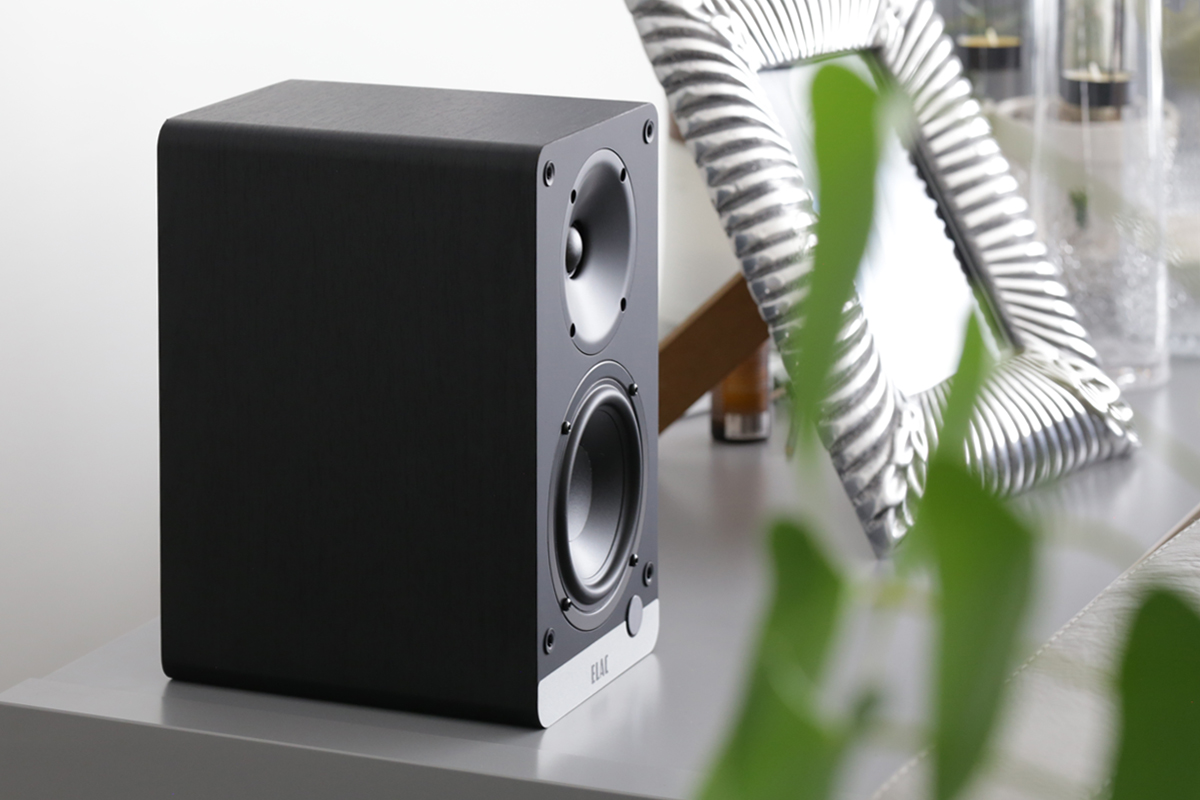
Of course, you’d expect a powered speaker system this small and this affordable to have limitations in dynamics, maximum SPL, and bass extension. But what struck me during my listening is how well Elac’s Debut ConneX DCB41 system manages these limitations. While I noticed some congestion and dynamic compression during my listening, I never heard an ugly sound from the DCB41. I always found it enjoyable and engaging. While I was working on this review, Doug Schneider told me that Oleg Bogdanov was very proud of the DCB41’s design. Quite rightly so.
. . . Gordon Brockhouse
Associated Equipment
- Active loudspeakers: SVS Prime Wireless Pro.
- Soundbar: Bowers & Wilkins Panorama 3.
- Sources: Pro-Ject Debut Carbon Evo with Ortofon 2M Red cartridge, Apple Mac Mini (M1, 2020) running Roon 2.0, Google Pixel 4a 5G smartphone, Samsung QN50LS003 50″ UHD TV “The Frame.”
- Speaker stands: IsoAcoustics ISO-130.
Elac Debut ConneX DCB41 Powered Loudspeaker System
Price: $599.98.
Warranty: Three years parts and labor, cabinets and drivers; electronics, one year.
Elac Americas, Inc.
1938 N. Batavia St., Suite K
Orange, CA 92865
Phone: (714) 252-8843
Website: www.elac.us
